Launched today at Singapore International Energy Week, the report provides information on nuclear energy developments in Asia, as well as an overview of the performance of nuclear reactors worldwide. It shows that global nuclear generation totalled 2563 TWh last year, up 61 TWh on 2017, and that the capacity of the world’s 449 operable reactors has risen by 4 GWe to 397 GWe.
"Nuclear energy is key to Asia meeting the twin challenges of a growing demand for electricity, and an urgent need to switch to less polluting, low-carbon generation sources," Agneta Rising, director general of World Nuclear Association, said. "More and more organisations are recognising that nuclear energy is vital to the goal of a sustainable future for people and the planet."
The report profiles Tarapur 1, a reactor located in Palghar, India, which marked 50 years of operation in April 2019. Four other reactors will match this achievement in 2019, the first year in which reactors have passed this milestone.
Worldwide nuclear generation in 2018 increased for the sixth successive year, reaching 2563 TWh. This is more than 10% of global electricity demand.
Nine new reactors were connected to the grid, with a combined capacity of 10.4 GWe. Seven reactors were closed down in 2018, with a combined capacity of 5.4 GWe. Of these, four are Japanese reactors that had not generated since 2011, and a fifth, Chinshan 1, had not generated since 2015, so these closures had minimal impact on overall electricity generation in 2018. Four reactors in Japan, with a combined capacity of 5.6 GWe, were given approval to restart.
The number of reactors under construction at the end of 2018 was 55, with construction starts on five reactors, compared to the nine that have been connected to the grid following completion of construction. In Asia, nuclear generation rose by more than 10%, to reach 533 TWh, now more than one-fifth of global generation. In China, the first AP1000 and EPR reactors began commercial operation, alongside Russian VVER V-428M and Chinese ACPR-1000 reactors. Although the four reactors gaining approval to restart in Japan brought the total number to nine, the pace of progress to restarting more reactors remains slow, continuing Japan’s reliance on fossil fuels.





_82983.jpg)
_34792.jpg)
_16403_79272.jpg)
_44458.jpg)

_76087_55556.jpg)



